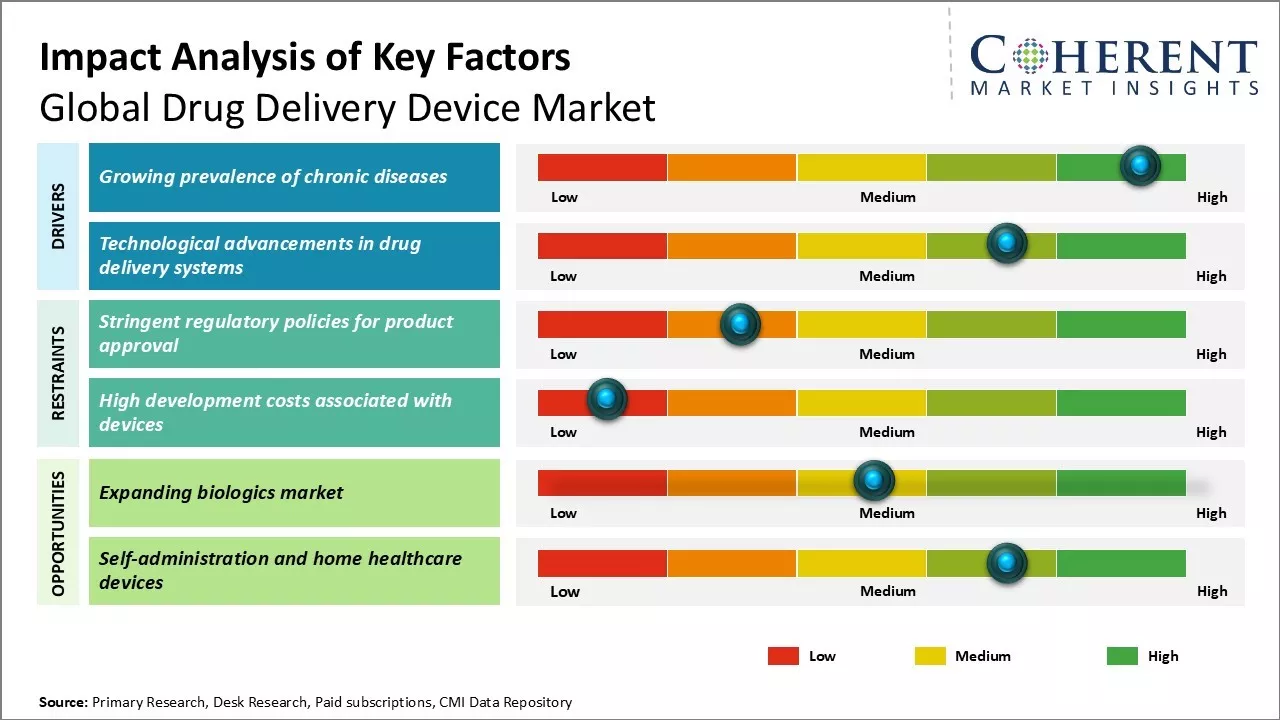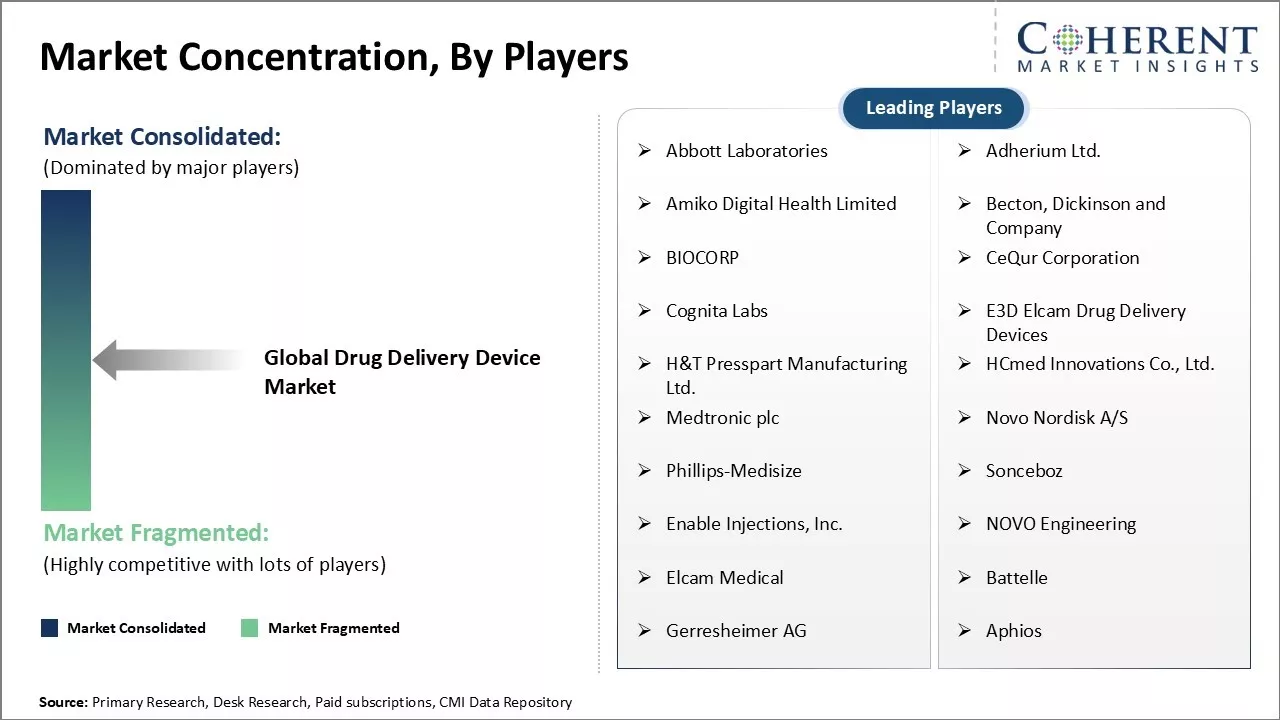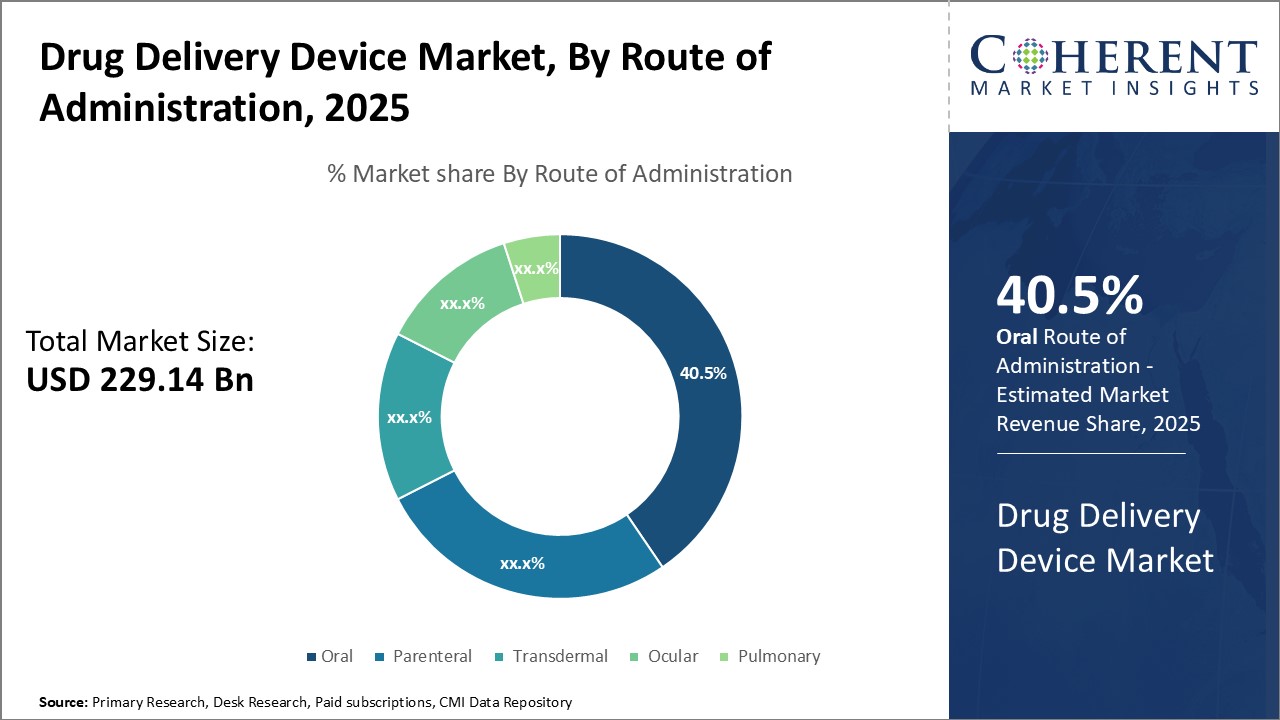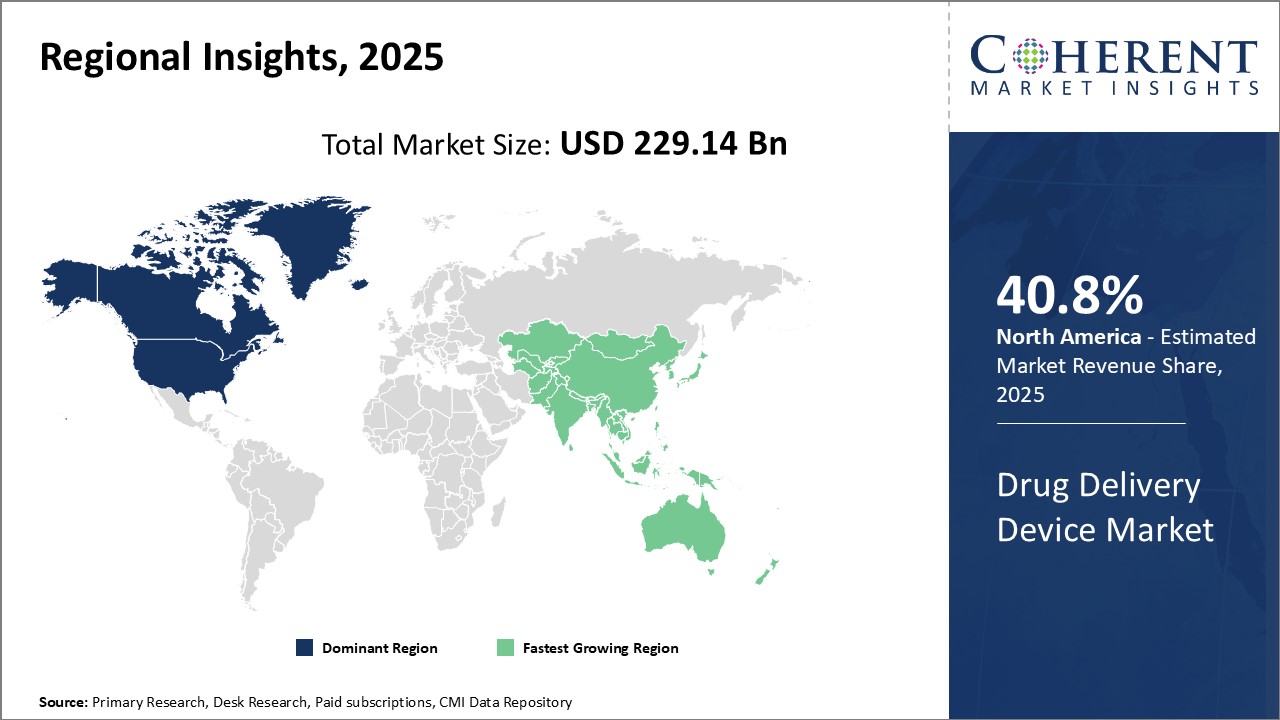Global drug delivery device market is estimated to be valued at USD 229.14 Bn in 2025 and is expected to reach USD 419.14 Bn by 2032, exhibiting a compound annual growth rate (CAGR) of 9.0% from 2025 to 2032.

Discover market dynamics shaping the industry: Request sample copy
Growing prevalence of chronic diseases
Growing prevalence of chronic diseases across the globe has boosted demand for advanced drug delivery devices. Chronic diseases such as diabetes, cardiovascular diseases, respiratory diseases and others require long term medical treatment and management. These diseases are often associated with side effects of drugs used for treatment, which can be minimized through effective drug delivery methods. Advanced drug delivery devices offer a controlled and targeted delivery of drugs, which helps patients to manage chronic conditions efficiently.
Many developed nations have witnessed substantial rise in life expectancy and aging population is more prone to chronic health issues. Developing countries are also witnessing epidemiological transition where infectious diseases are declining and non-communicable chronic diseases are increasing. This can be attributed to changes in lifestyle and environmental factors. Growing patient pool of chronic diseases worldwide has created an enormous market for innovative drug delivery devices. Companies are investing heavily in R&D to develop devices providing sustained release, minimal drug degradation and improved patient compliance. Wearable and portable delivery devices are gaining popularity for their convenience in administering drugs effectively without major lifestyle alterations.
Rising cases of diabetes can also drive the market growth. As per WHO, over 460 million people suffered with diabetes. Advanced insulin pens, pumps and inhalable formulations are revolutionizing diabetes management. Respiratory diseases also contribute significantly with over 300 million people suffering from asthma. Inhalers and nebulizers offering controlled medication delivery directly to lungs witness huge demand. Biologics have emerged as mainstay treatment for various cancers, autoimmune disorders and other chronic therapies. However, biologics are fragile large molecules having limited shelf life when administered conventionally. Specialized devices enabling stable storage and injectable delivery of biologics are opening new opportunities.

Get actionable strategies to beat competition: Request sample copy
Technological Advancements in Drug Delivery Systems
Rapid pace of innovation in drug delivery technologies has substantially expanded the capabilities and applications of devices. Advanced materials, miniaturization of components and digital integration boosts new product development. Microneedle patches provide painless intradermal access for vaccines and other drugs. Printed electronic skins enable controlled release of drugs through flexible polymer matrices. Implantable drug delivery systems using microchips and microtubules ensure precise long term dosing for conditions like contraception or Parkinson's disease. Wearables integrated with sensors and wireless connectivity allow automated monitoring and administration based on patients physiological needs.
3D printing revolutionizes the manufacturing of customized drug delivery solutions. Complex custom shapes required for sustained release formulations or targeted organ/tissue applications can now be precisely produced. It also offers possibilities for on-demand printing of devices. This reduces supply chain issues and production time. Integration of artificial intelligence and machine learning enable smarter devices. Pattern recognition of symptoms, predictive analysis of medication needs and automated device adjustments based on algorithms improve therapeutic outcomes. Miniaturization of electronics has facilitated development of microneedles and ingestible sensors within size limitations required for patient comfort.
Nanotechnology plays a massive role with nanoparticles, nanotubes, nanoemulsion and other nanocarriers vastly boosting solubility, stability and site-specific delivery of drugs. Smart biomaterials capable of changes in structure, properties or function in response to environmental stimuli ensure drugs are released only under pre-set biological conditions. Cellular therapies involving ex-vivo loading of drugs in stem cells before reintroduction in body holds potential for chronic diseases.
Key Takeaways from Analyst:
Global drug delivery device market growth is driven by rising prevalence of chronic diseases along with the growing geriatric population globally. Advancements in biologics and their delivery can also drive the market growth.
North America currently dominates the market due to high healthcare spending and presence of major players in the region. However, Asia Pacific is expected to be the fastest growing market led by countries like China and India. This can be attributed to rising healthcare expenditure, growing awareness regarding diseases, and increasing focus of international players to tap the opportunities in the emerging Asian markets.
Injectable delivery remains the most common mode owing to convenience. Oral delivery segment is gaining significant traction due to better patient compliance provided by oral routes of administration.
Non-compliance with prescriptions and device reusability can hamper the market growth. Complexity of device development and lengthy approval cycles can increase development costs. However, growing emphasis on self-administration by patients can offer opportunities for user-friendly devices with enhanced functionality. Moreover, combination products are gaining traction due to their dual benefit of delivering two solutions simultaneously.
Market Challenges: Stringent regulatory policies for product approval
Global drug delivery device market growth can be hampered due to stringent regulatory policies for product approval. Devices used for drug delivery are classified as medical devices, and hence, require approvals from regulatory bodies like the U.S. FDA and European Medicines Agency before these can be commercialized. Getting these approvals is a complex, costly and time-consuming process. Medical device manufacturers need to present clinical data demonstrating safety and efficacy of their products to obtain regulatory clearances. This involves conducting lengthy clinical trials under Good Clinical Practices. Any changes to an approved device may require renewed testing and approvals. Such stringent norms increase the cost and time involved in launching new products. This poses a major bottleneck in translating innovative drug delivery technologies into commercially available products. The rigorous regulatory oversight also poses compliance challenges for manufacturers throughout the product life cycle.
Market Opportunities: Expanding biologics market
Expanding biologics market can offer growth opportunities for global drug delivery device market. Biologics such as monoclonal antibodies and recombinant proteins have revolutionized the treatment of complex diseases like cancer and rare genetic disorders. Biologics often require parenteral delivery such as injections owing to their structural complexity. This boosts demand for prefilled syringes, auto-injectors, drug reconstitution devices and wearable drug delivery systems. It is projected that biologics will account for over 50% of the pharmaceutical market by 2030. As more biologics receive regulatory approvals and enter clinical use, it will spur the development of advanced devices that can administer these drugs in user-friendly formats. Rising biologics offers scope for innovation across secondary packaging, delivery modalities and connectivity in drug delivery devices. Many existing as well as emerging players are strategically focusing on this vertical for future growth opportunities.

Discover high revenue pocket segments and roadmap to it: Request sample copy
By Route of Administration - Convenience and compliance drives oral drug delivery segment
By route of administration, The oral segment dominates the Global Drug Delivery Device Market due to its widespread acceptance and convenience for both patients and healthcare providers. Oral drug delivery is non-invasive, making it more appealing for patient compliance compared to other methods like parenteral or transdermal routes. Additionally, advancements in formulation technologies have enabled the development of oral drugs with improved bioavailability and targeted delivery, further enhancing their effectiveness. The extensive use of oral medications for a wide range of chronic and acute conditions also contributes to the segment's dominance in the market.
By Application - Targeted treatment drives parenteral drug delivery
By application, oncology segment is estimated to account for highest market share of 20.5%. Growing incidence of cancer worldwide and the need for targeted and effective drug delivery solutions can drive the segment growth. Cancer treatments often require sophisticated drug delivery devices, such as implantable drug pumps, infusion systems, and transdermal patches, which can deliver medications precisely to the affected areas while minimizing systemic side effects.
By End User - Ease of administration boosts transdermal drug delivery
By end user, hospitals segment is estimated to account for highest market share of 45.5%, due to increasing demand for advanced drug delivery technologies in healthcare settings, where patients require comprehensive and specialized care. Hospitals and clinics have the necessary infrastructure, trained healthcare professionals, and access to the latest medical technologies to effectively utilize and manage a wide range of drug delivery devices, from traditional oral formulations to complex parenteral and transdermal systems.

Need a Different Region or Segment? Customize now
North America dominates the global drug delivery device market, with an estimated market share of 40.8% in 2025, due to its strong pharmaceutical industry presence and rapid adoption of advanced drug delivery technologies. The U.S. accounts for the largest share primarily due to presence of many pharmaceutical giants and rising healthcare expenditure. Moreover, favorable reimbursement policies for specialty drugs and devices can increase the affordability of treatment. Significant R&D investments by device manufacturers towards innovative devices for injectable and inhaled drugs can drive the market growth.
Asia Pacific is recognized as the fastest growing region in the drug delivery device market due to expanding patient pool arising from the burgeoning geriatric population and prevalence of chronic diseases such as diabetes. Countries like China and India are emerging as the major contributors, owing to their low manufacturing costs and significant exports. The region also holds immense potential for self-injectable devices as consumers are increasingly opting for home healthcare solutions to avoid high hospital bills. This compel device companies to focus on developing user-friendly designs specifically for the Asian demographic.
While North America and Europe traditionally dominated the high-end market, Asia Pacific is gradually increasing its presence at both ends of the value chain. Many Asian manufacturers are offering affordable devices to meet the demand from price-sensitive emerging markets within the region and in Latin America and Africa. = Taiwan and South Korea have become key export hubs globally. Coupled with initiatives towards promoting domestic production of medical supplies, countries are actively working to achieve self-sufficiency. Meanwhile, international players are either setting up local manufacturing units or collaborating with regional innovators to capitalize on the regional opportunities. Evolving healthcare needs across populations at different economic levels make Asia Pacific an integral market for drug delivery solutions.
Report Coverage
| Report Coverage | Details | ||
|---|---|---|---|
| Base Year: | 2024 | Market Size in 2025: | USD 229.14 Bn |
| Historical Data for: | 2020 To 2024 | Forecast Period: | 2025 To 2032 |
| Forecast Period 2025 to 2032 CAGR: | 9.0% | 2032 Value Projection: | USD 419.14 Bn |
| Geographies covered: |
|
||
| Segments covered: |
|
||
| Companies covered: |
Abbott Laboratories, Adherium Ltd., Amiko Digital Health Limited, Becton, Dickinson and Company, BIOCORP, CeQur Corporation, Cognita Labs, E3D Elcam Drug Delivery Devices, H&T Presspart Manufacturing Ltd., HCmed Innovations Co., Ltd., Medtronic plc, Novo Nordisk A/S, Phillips-Medisize, Sonceboz, Enable Injections, Inc., NOVO Engineering, Elcam Medical, Battelle, Gerresheimer AG, Aphios |
||
| Growth Drivers: |
|
||
| Restraints & Challenges: |
|
||
Uncover macros and micros vetted on 75+ parameters: Get instant access to report
*Definition: Global Drug Delivery Device Market provides devices that assist in the delivery or administration of pharmaceutical drugs and biologics. This market includes devices for oral administration, inhalation, transdermal patches, and injectable devices like syringes, autoinjectors, and infusion/insulin pumps. The demand for such devices is driven by need for innovative technologies that can improve patient compliance and quality of care across therapeutic areas such as diabetes, cancer, autoimmune diseases.
Share
Share
About Author
Manisha Vibhute is a consultant with over 5 years of experience in market research and consulting. With a strong understanding of market dynamics, Manisha assists clients in developing effective market access strategies. She helps medical device companies navigate pricing, reimbursement, and regulatory pathways to ensure successful product launches.
Missing comfort of reading report in your local language? Find your preferred language :
Transform your Strategy with Exclusive Trending Reports :
Frequently Asked Questions
Joining thousands of companies around the world committed to making the Excellent Business Solutions.
View All Our Clients
US Reciprocal Tax Impact Analysis On Drug Delivery Device Market
Stay updated on tariff changes with expert insights and timely information